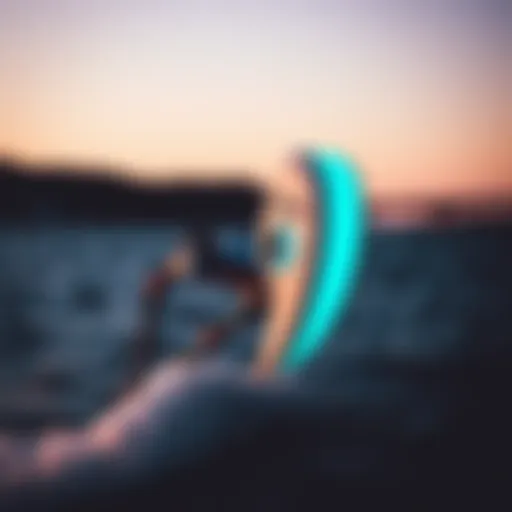Top Light Wind Kites for Kiteboarding Enthusiasts
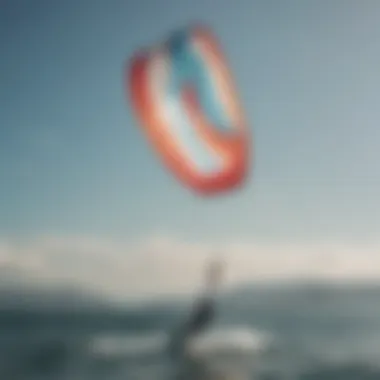

Intro
Kiteboarding, as exhilarating as it is, can become a test of patience when the winds are barely brushing the surface of the water. For enthusiasts in search of those perfect days when they can harness the gentlest breezes, choosing the right equipment is key. This piece will unravel the best options for light wind kites, making it a must-read for anyone keen on squeezing every ounce of fun out of low-wind days.
As we navigate through this guide, we’ll pinpoint the inventions and designs that make light wind kites distinctive. A kite designed for minimal wind is not just a smaller version of its stronger counterparts. Instead, it encompasses various elements that enhance lift, stability, and control, crucial for an enjoyable ride when Mother Nature is feeling a tad lazy.
"Selecting the right kite can mean the difference between gliding gracefully over the water or spending your day lounging on the beach, waiting for a gust."
Without further ado, let's dive into our Equipment Insights to better understand what makes the best light wind kites tick.
Intro to Light Wind Kites
Kiteboarding in light winds can often seem like an uphill battle; Yet, those who know the tricks of the trade understand the joys that can be had. In this segment, we focus on light wind kites, describing their vital role in maximizing the kiteboarding experience when wind speeds are lower than ideal. Light wind conditions require specific kites that excel in generating lift and maintaining stability, thus allowing a seamless ride.
Light wind kites are crafted distinctly, with unique sizes, shapes, and materials that enable riders to glide effortlessly, even when the breeze is barely a whisper. Choosing the right kite isn't merely a matter of personal preference; it's paramount for achieving the best performance and enjoyment.
Understanding Light Wind Conditions
Light wind conditions are defined by gentle breezes typically ranging from around 5 to 15 knots. During these times, many kiteboarders find themselves yearning for the perfect setup that keeps their spirits high. However, those seeking to bask in the tranquility of lighter winds must bear in mind several factors that shape their experience.
- Consistent Wind Direction: A steady, consistent wind direction becomes essential, as it allows for smoother rides and better control.
- Wind Variability: Light wind can fluctuate unexpectedly, and while it can stir excitement, it also demands that riders remain alert and adaptable to change.
- Water Conditions: The nature of the water also plays a significant role; flat and calm waters offer more favorable conditions for kiteboarding.
Ultimately, understanding these elements gives kiteboarders an edge, allowing them to plan and strategize their sessions with confidence.
Importance of Selecting the Right Kite
Selecting an appropriate kite for light wind conditions cannot be overstated. The impact of this decision can be the difference between a gratifying experience or a frustrating one filled with flubbed attempts and disappointing results.
- Size Matters: A larger kite may seem appealing, promising to catch more wind; however, it also risks being harder to control, especially when winds pick up unexpectedly. A well-size kite leads to improved handling.
- Weight Distribution: The rider’s weight and style can greatly affect kite selection. Heavier riders may benefit from a bit more surface area, while lighter riders can opt for more maneuverable designs.
- Performance Features: Each kite is engineered with a set of features tailored specifically for different wind conditions. Riders should be deliberate in understanding these features, such as aspect ratio, material composition, and overall build quality, to ensure they select the best fit for their needs.
"When the winds are kind, the right kite can transform a simple session into a magical experience."
The light wind experience in kiteboarding shouldn’t be underestimated. With a grasp of light wind conditions and an informed choice of kite, riders can navigate the waters with ease and confidence.
Key Features of Light Wind Kites
When it comes to kiteboarding, especially in light wind conditions, the choice of kite can make or break your experience on the water. Light wind kites need to have certain features that set them apart from standard kites. These features are essential for ensuring that riders can maximize performance and enjoyment when facing calm breezes. Let’s delve deeper into these crucial aspects and what they mean for you.
Size and Shape Considerations
The size and shape of a kite are pivotal elements in its performance, particularly in light winds. Typically, light wind kites are larger than their standard counterparts, as this additional surface area helps to catch more wind, which translates to better lift and acceleration. Imagine trying to sail a small boat in a gentle breeze; it just doesn't have the sail area necessary to harness the wind effectively.
Kites in this category often feature a high-aspect ratio, which means they are longer in relation to their width. This design not only aids in flying upwind but also helps generate lift even in the gentlest gusts. Another significant element is the shape of the kite's canopy. A flatter shape can increase efficiency through the wind, while a more pronounced curvature enhances its ability to fly in lower airs.
In terms of riding style, while choosing the right size is paramount, you should also consider your own weight and skill level because they influence how effectively you can control the kite.
Material Composition and Durability
Durability is key when selecting a light wind kite, given that these kites are often pushed to their limits in variable conditions. The material composition plays a huge role in how well your kite withstands the test of time. While some kites utilize lightweight materials to enhance performance, it's essential to balance weight with robustness.
Common materials include ripstop nylon or polyester, which provide a good resistance to tears while still being light enough to facilitate impressive flying capabilities. However, keep in mind that while these materials are generally durable, exposure to the sun's UV rays can weaken them over time.
Taking care of your kite and periodically inspecting it for any wear and tear certainly goes a long way. Ensuring the seams, bladders, and canopies are intact will preserve its integrity, ultimately prolonging your time on the water.
Aspect Ratio and Its Impact
The aspect ratio of a kite refers to the relationship between its width and height. A higher aspect ratio means the kite is designed to be taller than it is wide, which can often provide superior lift in light winds. This design choice has a direct impact on how the kite behaves. If you’ve ever flown a kite that just didn’t want to get off the ground, you understand the frustration that comes from low lift.
A kite with a high aspect ratio tends to handle wind updrafts better, allowing for smoother, more controlled ascents. Conversely, lower aspect ratio kites offer greater stability and easier handling, making them suitable for those who may just be starting out or looking for a more forgiving flight experience. Ultimately, understanding your personal preferences and riding style will help in choosing the right aspect ratio for your light wind kite needs.
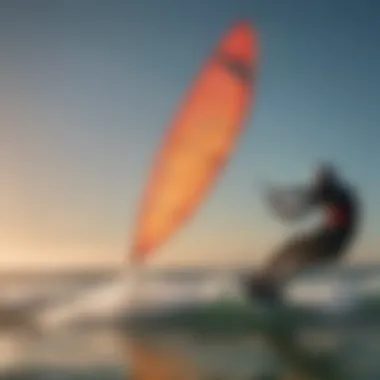

"In light wind conditions, every detail counts. It’s not just about catching a breeze; it's about mastering the art of riding with finesse."
The specific features of light wind kites, from their size and shape to the materials they are made from, significantly affect how they perform in less than ideal wind conditions. Knowledge about these key aspects allows kiteboarders to make informed choices that align with their goals and riding styles.
Types of Light Wind Kites
Understanding the different types of light wind kites is crucial for kiteboarders who want to make the most of low-wind conditions. When the breeze is barely there, having the right kite can be the difference between gliding across the water or sitting helplessly while others have all the fun. Knowing the pros and cons of each type helps you select the best fit for your riding style, skill level, and preferred conditions.
Freeride Kites
Freeride kites are often thought of as the bread and butter of light wind kiteboarding. Designed for versatility, these kites offer a balance between performance and ease of use. They generally feature a larger surface area, allowing them to catch more wind, which is crucial when conditions are less than ideal.
One of the biggest advantages of freeride kites is their ability to generate lift while maintaining stability. This means that even when the wind is light, you can still experience a decent acceleration off the water. Freeride kites often come with a medium aspect ratio, which contributes to a smoother ride and comfortable handling.
However, not all freeride kites are created equal. Riders need to consider their own weight when selecting a model. Heavier riders may require something more powerful to get going, whereas lighter riders might find more success with a smaller, more manageable kite.
Foil Kites
Foil kites are a game-changer in the world of light wind kiteboarding. Unlike traditional inflatables, these kites consist of an aerodynamic frame made from a variety of materials. They trap air within their layers, enabling them to fly with less wind compared to their inflatable counterparts.
The design allows foil kites to maintain excellent lift and glide, making them superb for light wind conditions. Some riders swear by them, citing their ability to catch even the faintest breeze. However, they do require a different approach to handling. Maneuvering foil kites takes finesse, and they may not be the best choice for novice kiteboarders.
One thing to keep in mind is their price point. Foil kites can often be more expensive due to their sophisticated construction and material. Nonetheless, many consider them to be a worthy investment if you seek performance in light winds.
Hybrid Designs
Hybrid kites combine elements from both freeride and foil kites, creating a unique option for those who want the best of both worlds. This type of kite typically features a solid leading edge and struts like inflatables but has the lightweight nature of a foil kite.
A key benefit of hybrid kites is their ability to perform well across a range of wind conditions. They offer punchy power in lighter winds while maintaining stability in stronger breezes. Riders enjoy versatility without needing to take multiple kites to the beach.
When choosing a hybrid, consider your skill level and preferred riding style. These kites can be perfect for those who enjoy a bit of everything— from casual cruising to small jumps and tricks.
"The right kite can transform how you experience the water, especially when the wind is playing hard to get. Choose wisely!"
In summary, understanding the distinct features of freeride kites, foil kites, and hybrid designs can significantly impact the kiteboarding experience in light winds. Each type has its strengths and weaknesses, so recognizing what aligns best with your personal style and conditions is crucial.
Top Light Wind Kites in the Market
When you’re out there trying to catch some wind while kiteboarding, the type of kite you choose can make all the difference. Light wind kites are designed specifically to maximize performance on those lazy, less than breezy days. Selecting the right kite can result in a day filled with joy instead of frustration, which makes discussing the best options in the market so critical.
With a plethora of light wind kites available, understanding their distinct features can help kiteboarders make informed choices. Let’s explore several brands that have made waves, detailing essential aspects of their kites, performance variances, and user insights.
Brand A: Features and Performance
Brand A has crafted a reputation for delivering reliable light wind kites that often stand the test of time. One of the standout models features a generous surface area combined with sleek aerodynamic design, allowing it to effortlessly float even in the slightest breeze. Kiteboarders have praised this specific model for its quick acceleration—a crucial factor when you’re trying to maintain momentum in light winds.
In terms of material, Brand A employs high-quality ripstop fabric that not only resists tearing but also promotes durability against prolonged sun exposure. Users often rave about its lightweight nature, which enhances ease of handling and control. As a bonus, the adjustable bridles prove advantageous, allowing riders to customize their flying experience depending on the wind conditions.
Brand B: Comparison of Models
When examining Brand B, it’s clear that they cater to a wide range of riding styles with distinct models aimed at different preferences. Their light wind kites, while sharing some core characteristics, each boasts unique features. For instance, Model X emphasizes responsiveness, making it ideal for those who enjoy more aggressive turns and tricks. On the other hand, Model Y is tailored for stability, perfect when riding in variable winds.
- Model X: Quick response time, agile maneuvering, less drag.
- Model Y: Enhanced stability, predictable behavior, better for beginners.
This variety allows kiteboarders to pick and choose based on their individual skill level and riding habits. Additionally, comparing these models illuminates how a nuanced choice can significantly impact overall performance.
Brand C: User Reviews and Feedback
User reviews can be as enlightening as any professional assessment when it comes to kite performance. Brand C's light wind kites have gained attention due to their balance of performance and accessibility. Feedback often highlights the kite's ability to remain steady in lulls, ensuring that even less experienced riders feel secure. Many enthusiasts appreciate the feeling of control, often mentioning how it reduces the intimidation factor when learning or navigating soft winds.
Interestingly, one review described a user’s first light wind session with Brand C’s kite as "an eye-opener"—they hadn’t realized just how enjoyable low-wind conditions could be when using the right equipment. The consensus among users is that for those new to kiteboarding, Brand C provides a forgiving experience that encourages skill progression.
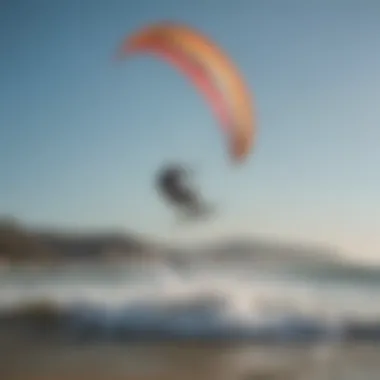

In the end, choosing the right light wind kite involves scrutinizing brand offerings, understanding your own riding style, and weighing the experiences of fellow kiteboarders. This journey through the market reveals not just products, but the community that surrounds them, ultimately enhancing your time on the water.
Evaluating Kite Performance in Light Winds
When it comes to kiteboarding in light winds, performance evaluation becomes crucial. Not all kites are created equal; some excel when the breezes are weak and fickle. Understanding how your kite performs under these conditions can significantly affect your experience on the water, and even influence your overall enjoyment of the sport.
Evaluating kite performance in light winds involves three primary elements: acceleration and lift, stability and response, and handling and control. Each factor plays a role that, when harmonized, can create a seamless ride. Let’s take a closer look at these aspects one by one.
Acceleration and Lift
In light wind conditions, acceleration and lift are vital for maintaining momentum. A kite that lacks proper lift may leave a rider feeling sluggish, making it difficult to get off the ground or ride effectively. The shape and size of the kite contribute significantly to these performance characteristics.
- Larger Surface Area: A kite with a larger surface area generates more lift, which is essential for lifting a rider off the water. This is especially valuable in lighter winds, where every bit of lift counts.
- Softer Leading Edge: Kites designed with a softer leading edge allow for better performance at lower speeds, contributing to a smoother take-off.
Tuning in your kite’s angle can also make a world of difference; when set correctly, the kite should accelerate smoothly and allow for easy lift.
Stability and Response
Stability in light winds reflects a kite's capacity to hold its position in the air without excessive flutter or movement. Riders looking for a smooth ride should pay attention to the response rate of their kite, especially under less consistent wind conditions.
- Wider Wingspan: A wider wingspan typically contributes to greater stability as it provides a more consistent pull through different wind pockets. This minimizes wave-induced movements, allowing for smoother transitions.
- Bridle Systems: Kites outfitted with well-designed bridle systems can offer improved stability due to the way they control the angle of attack.
Conversely, the responsiveness of a kite affects how quickly it reacts to rider inputs. This is vital in light winds since making sharp turns or quick adjustments can help maintain speed and control.
Handling and Control
Finally, handling and control determine how intuitive and user-friendly a kite feels while riding. A kite that behaves predictably makes it easier for riders to focus on their technique, rather than constantly compensating for erratic movements.
- Light Weight Materials: Materials that reduce the overall weight of the kite can lead to improved handling. Lighter kites are often easier to maneuver, particularly when the wind is gentle.
- Adjustable Settings: Kites that include adjustable settings can be tailored to different riding styles, giving riders a sense of control and predictability.
Overall, a kite that combines these elements will likely create a more enjoyable experience for kiteboarders dealing with light winds. Balancing acceleration, lift, stability, and handling can be the make-or-break factors that lead to a great day on the water, even when the winds are less than favorable.
"The essence of kiteboarding in light winds lies not just in the kite but in understanding how to leverage its strengths."
By grasping how these performance characteristics come into play, riders can choose the right kite to match their personal style and preferences, ensuring they make the most of those calm days on the water.
Selecting the Appropriate Kite for Your Style
When it comes to kiteboarding, the kite you choose can make or break your experience on the water. Selecting the appropriate kite isn't just about personal preference; it's about alignining with your specific riding style and the conditions you'll be facing. Using the right kite can significantly improve your performance, comfort, and overall enjoyment. Light wind kites are designed to harness those gentle breezes, but they come in various shapes and sizes, each tailored to different needs.
Rider Weight and Skill Level Considerations
Rider weight and skill level play a crucial role in determining what kind of kite is best for an individual. For instance, heavier riders tend to need a larger kite to generate more lift and maintain speed in light winds. Conversely, lighter riders can often achieve sufficient lift with a smaller kite. But it’s not just about size—experience matters too.
- Beginner Kiteboarders: Those new to the sport should consider kites that offer substantial stability and predictability. A larger, trusted model can help with easier takeoffs and landings, balancing power and control. For example, a kite like the Cabrinha Nitro could provide the necessary protection against mishaps on the water.
- Intermediate and Advanced Riders: More experienced riders might lean toward kites with a bit more agility and responsiveness. They may find that they’re more suited to a high-aspect ratio kite that allows for quick turns and enhanced performance. Brands like North Kiteboarding offer models that cater to this market well.
Keep in mind, kiteboarding isn't a one-size-fits-all sport. As an individual grows in skill, so should their choice of equipment. Riders should also engage in self-assessment before stepping onto the water. Factors like height, weight, and wind conditions should all be scrutinized. It’s worth noting—if you’re in between sizes, opting for a larger kite can aid in stability and control, especially in unpredictable light winds.
Preferred Riding Conditions and Locations
Where you intend to ride also dictates the type of kite that will serve you best. Different locations offer various environmental factors that can impact kiteboarding experiences. For example:
- Open Oceans: If you’re looking to ride on wide-open waters, consider a kite designed for a steady pull that can handle gusty winds. Kites like the Duotone Evo can perform exceptionally well in this sort of environment, providing a consistent pull.
- Choppy Waters: For choppy conditions, a kite with a responsive design may work better. A model such as the Slingshot Ghost gives riders the adjustment needed for quick maneuvers and swift changes in direction.
- Flat Lakes: Riding in flat water is a treat for many kiteboarders. The versatility of a more balanced kite can make your experience seamless. If you often find yourself at spots with steady wind, like in some regions in Texas, you might consider a kite with a higher aspect ratio tailored for flat-water riding.
Ultimately, the best kite for any given individual comes down to personal preference combined with careful consideration of both rider weight and local conditions. As always, it’s wise to test different kites when possible to see which setup you gel with the best. Remember to consult rider reviews and connect with fellow kiteboarding enthusiasts to gain insight that may not always be visible in product specifications.
Care and Maintenance of Light Wind Kites
Taking care of your light wind kite is just as important as selecting the right one. Proper maintenance keeps your kite in top shape, prolonging its lifespan and ensuring optimal performance when you hit the water. If you've invested in a quality kiteboarding experience, maintaining your gear becomes essential to protect your investment and your riding experience.
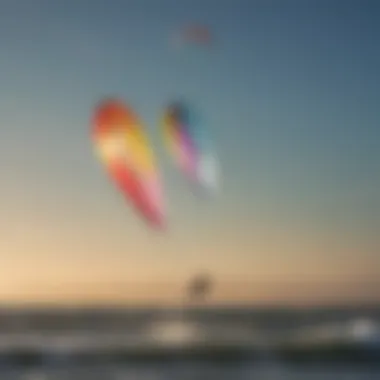

Regular Cleaning Procedures
Keeping your light wind kites clean is a no-brainer. Every time you get out of the water, salt, sand, and dirt can cling onto the fabric and components. Regular cleaning helps to prevent wear and tear.
First things first, rinse your kite with fresh water after each session. This simple act serves a dual purpose: it not only removes the salt and dirt but also preps the fabric for any further care it might need. You would be amazed how this one action can work wonders.
- Step 1: Grab a hose or a bucket, and inundate your kite with fresh water.
- Step 2: Use a soft sponge or cloth to wipe down the surface. Avoid harsh chemicals or brushes, as they may lead to damage.
- Step 3: Pay close attention to the seams and corners where dirt tends to accumulate.
- Step 4: After washing, let it air dry—avoid direct sunlight, as UV rays can degrade the material over time.
This routine is crucial to your kite's longevity. Think of it this way: regularly cleaning your kite is like changing the oil in your car. Ignore it, and you're bound to run into problems sooner or later.
Storage and Transport Best Practices
Now that your kite is squeaky clean, it’s time to focus on how you store and transport it. Proper storage goes hand-in-hand with maintenance. Bad storage decisions can lead to all sorts of issues, from fabric wrinkles to costly repairs.
For starters, always keep your kite out of extreme temperatures. Heat can warp the structure, and cold can make the material brittle. Ideally, store your kite in a dry, cool area away from direct sunlight.
- Use a kite bag: Invest in a quality kite bag for transport. Not only does it protect against scrapes, but it also makes carrying your gear a breeze.
- Don’t leave it bunched up: When storing, avoid leaving your kite crammed into a small space, as this can cause creases which would affect its performance.
- Remove all parts: Before transport, take off all accessories like lines and bars. This helps prevent tangling and makes for a cleaner setup when you reach your destination.
"The time you invest in maintaining your kite today can save you headaches tomorrow."
Each of these practices is like a stitch in the fabric of good kite care. If neglected, you may find yourself cutting your day short because your gear didn’t stand up to the conditions. Remember, a kite well taken care of can take you further and keep you riding longer.
Future Innovations in Light Wind Kite Technology
As the sport of kiteboarding evolves, the focus on maximizing performance in light wind conditions also shifts toward innovation. Future innovations in light wind kite technology will play a crucial role in how riders experience their time on the water. These advancements help bridge the gap that has traditionally existed between lower wind speeds and effective riding, opening new horizons for both enthusiasts and professionals alike.
The significance of continual development in kite technology cannot be overstated. Using cutting-edge materials and design philosophies improves overall stability and maneuverability, while also enhancing the rider's capability to perform in otherwise challenging conditions. When you consider how critical every knot of wind is in light air, innovations like these can mean the difference between an exhilarating session and a long day waiting for the breeze.
Advancements in Materials
In recent years, kite manufacturers have made leaps in material science, focusing on fabrics and construction that enhance lightweight yet robust qualities. The introduction of ultra-lightweight ripstop nylon and reinforced stitching techniques has allowed kites to become more efficient in light winds. These materials contribute to improved durability while simultaneously reducing drag, which is essential when you're depending on just a whisper of a breeze.
A notable trend is the development of composite materials that blend strength and flexibility. These innovations enable the kite to maintain shape and form during low wind conditions, allowing for improved lift. As a kite sacrifices weight, it gains versatility, reacting better to subtle shifts in wind direction. Plus, materials such as Dyneema offer increased resistance to wear, meaning less frequent replacements and lower long-term costs for riders.
- Key Advantages of Material Innovations:
- Reduced Weight: Leading to improved responsiveness in light wind.
- Enhanced Durability: Cutting back on the need for repairs or replacements.
- Resistance to Environmental Effects: Protecting against UV damage and saltwater wear.
Next-Generation Designs
Looking forward, the designs of light wind kites are already starting to diverge from what we've known in the past. Kite design is not just about aesthetics; it's increasingly shaped by performance characteristics, with features such as swept-back wingtips and innovative strut configurations that allow for better airflow over the surfaces. These new designs focus on maximizing lift while minimizing resistance, which is a game changer when the wind is light.
Next-generation kites often feature adjustable bridles that can adapt their angle and shape depending on rider needs. This allows pilots to optimize their kite setups for the specific conditions they encounter, giving them more control and versatility in low-wind scenarios. Moreover, many designs now incorporate a focus on direct linearity, which helps maintain stability.
"It's not just about catching the wind; it's about harnessing every possible strand of it. New kite designs aim to do just that, improving performance in ways that seemed impossible only a few years back." - Kiteboarding expert.
Embracing innovation means being prepared to adapt to changing conditions on the water. Next-generation kites will likely come equipped with features such as smart technology, aiming to enhance user experience—whether that’s through embedded sensors or connectivity for real-time feedback on performance metrics during rides.
In summary, future innovations in materials and designs signal an exciting era for light wind kiteboarding. As these technologies continue to evolve, they promise to transform how riders interact with the elements, making light wind days something to look forward to, rather than merely endure.
End
When wrapping up the topic of light wind kites, it’s crucial to reflect on the primary elements that contribute to an informed decision in kiteboarding. Selecting the right kite for low-wind conditions isn’t merely about preference; it’s about ensuring an enjoyable and safe experience on the water. Light wind kites come with several defining features that cater specifically to conditions that others might find lacking.
Summary of Key Points
Light wind kites are crafted for efficiency, helping kiteboarders harness every ounce of wind that brushes the surface. Here are some pivotal points to remember:
- Design Features: Optimal size and shape significantly affect how well a kite performs in low-wind conditions. A larger surface area allows for greater lift, while specific shapes might enhance stability.
- Material Quality: Durability plays a vital role in kite selection. High-quality materials ensure longevity and reduce the chances of malfunctions or injuries during usage.
- Tailored Performance: The individual's weight and skill level are key factors in finding the ideal kite, as they determine how the kite will respond to shifting winds.
From the various types of kites—be it freeride, foil, or hybrid designs, the nuances you choose can have a monumental impact on your overall experience. Specific models from notable brands have set high standards, but rider feedback and personal trials can also guide the decision-making process.
Final Thoughts on Choosing the Best Light Wind Kite
Moreover, individual experience—what you like or dislike about a kite—can’t be overlooked. Remember, kiteboarding isn’t just about getting out there; it is an art form that thrives on personal connection.
So don’t shy away from asking fellow riders for their recommendations, or dive into forums like reddit.com or kiteboarding communities on facebook.com. The collective wisdom of a vibrant kiteboarding community can offer insights and personal anecdotes that enrich your understanding and ultimately help shape your choices.
In the end, whether you're navigating the smooth waters of a lake or the unpredictable gusts of the ocean, selecting the right light wind kite can make all the difference in not just getting out there, but truly enjoying the ride.

